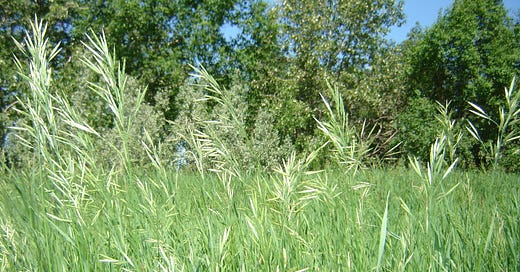Earlier this year, I read a book that changed my perspective as an ecologist and as a human being. Braiding Sweetgrass by Robin Wall Kimmerer was recommended to me by a friend in my graduate program, and I only wish I had picked it up sooner.
Through a series of stories and personal essays, Kimmerer weaves a beautiful narrative of Indigenous history, motherhood, science, language, and ecological and botanical knowledge. The title of the book, “Braiding Sweetgrass,” speaks to Kimmerer’s Potawatomi heritage – sweetgrass is given as a symbol of kindness and gratitude, braided to represent the hair of Mother Earth. And the book itself feels like a gift, the stories woven together into a complex braided narrative.
From a literature perspective, it’s worth a read for Kimmerer’s captivating use of language and rich descriptions. But as an ecologist, Braiding Sweetgrass spoke to me deeply.
While I think ecology has made great strides to acknowledge Indigenous science and perspectives, most ecology is still taught in a classroom as a set of biological and mathematical principles. We learn how populations respond to the removal of predators, what nutrients are necessary for plant productivity, how to integrate conservation into urban areas.
But ecology taught in a concrete building in a Western university always lacks love. It lacks the connection and reciprocity that Kimmerer describes in her book. I know so many ecologists (myself included) who absolutely adore the Earth, who want to care for it and heal it. But that adoration is not a fundamental part of our formal education.
Kimmerer puts love at the center of ecology.
When she describes her desire to study botany in college, it is because she wants to understand why goldenrod and asters grow beside each other. Her advisor brushes off her curiosity and insists that botany is studied by the book, but when Kimmerer attends a talk by a Navajo elder, she is reminded that plant science is about beauty and curiosity, and that Indigenous wisdom goes much deeper than university botany courses.
When Kimmerer describes the process of cleaning algae out of a pond, it is because she wants to be a good mother. She discusses the process of eutrophication, the algal species that live in the water, the pond organisms she observes under her microscope. But all of this science is because she wants to provide a place for her daughters (and the local ducks) to swim.
The chapter that spoke to me the most was Kimmerer’s account of research she and a graduate student conducted on sweetgrass (wiingaashk in Potawatomi). Her student wanted to determine the effect of traditional harvesting practices on endangered sweetgrass populations.
The project was ridiculed by professors who claimed, “Anyone knows that harvesting a plant will damage the population.” There was a time when I would have thought the same thing, having been taught that human-ecosystem relationships are inherently one-sided and extractive. But Kimmerer’s graduate student showed that judicious harvesting of sweetgrass, as is customary by Indigenous peoples, actually allows the grass to flourish, released from competition with its neighbors.
This information was, of course, not news to Indigenous basket makers. Indigenous knowledge is often ignored until is “confirmed” by research scientists, but these practices exist because of generations of experience.
This story inspired a shift in my personal ecological perspective. Human beings are not fundamentally destructive. We are, like any other plant or animal or fungus or microbe, a part of the ecosystem. And we can form mutual, reciprocal relationships with other species.
Sweetgrass evolved to thrive with human harvesting. As long as we are respectful and prudent, we can shape our environment for the better.
It was beautiful to read this chapter, and it encouraged me to view my research not just as a study system, but as an extension of my home, and with love and curiosity. And I think I am a better ecologist for it.
I believe Braiding Sweetgrass should be required reading for ecologists, and honestly, for human beings in general. We have much to learn from Indigenous perspectives when it comes to the environment and sustainability, and this book elegantly and lovingly introduces these concepts. I highly recommend it.
“It is an odd dichotomy we have set for ourselves, between loving people and loving land. We know that loving a person has agency and power – we know it can change everything. Yet we act as if loving the land is an internal affair that has no energy outside the confines of our head and heart.” – Robin Wall Kimmerer, Braiding Sweetgrass



